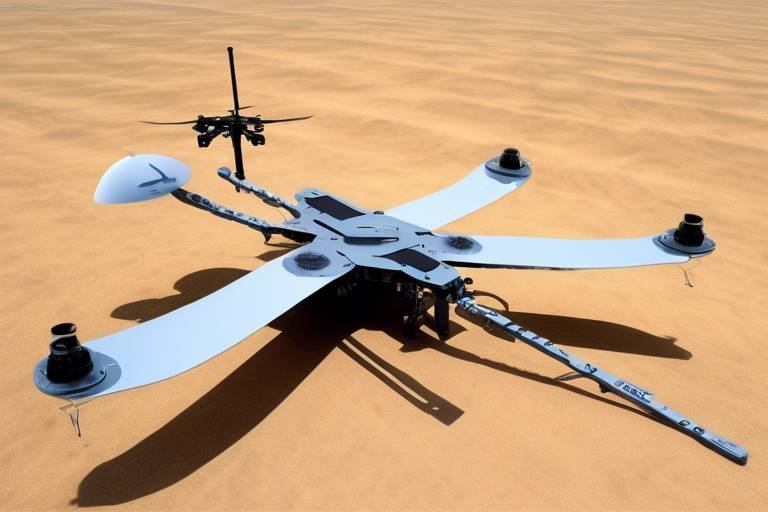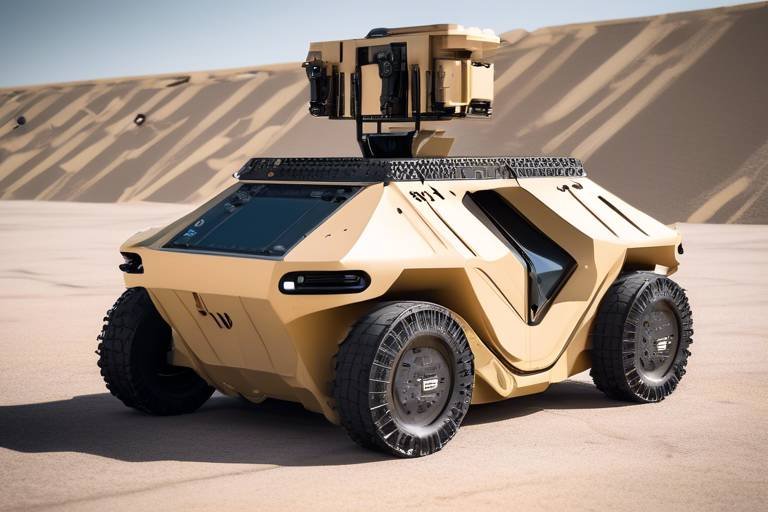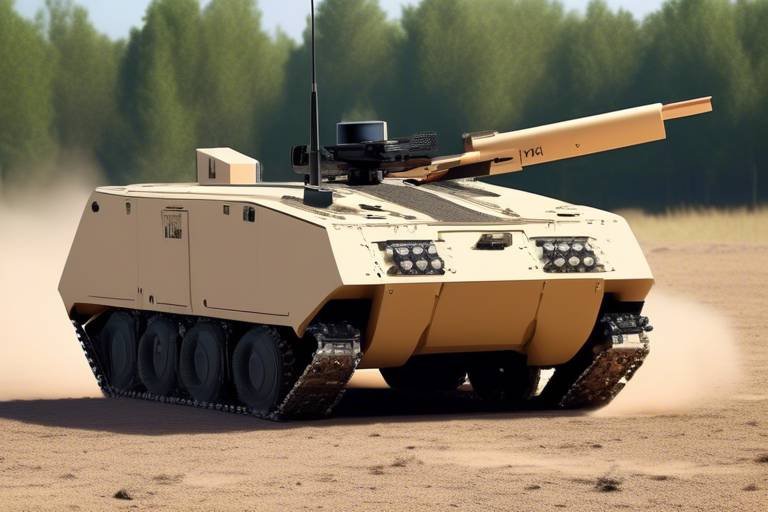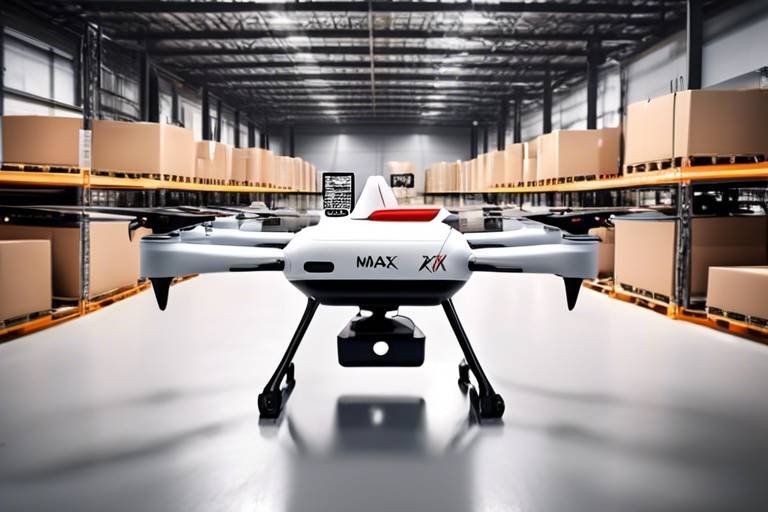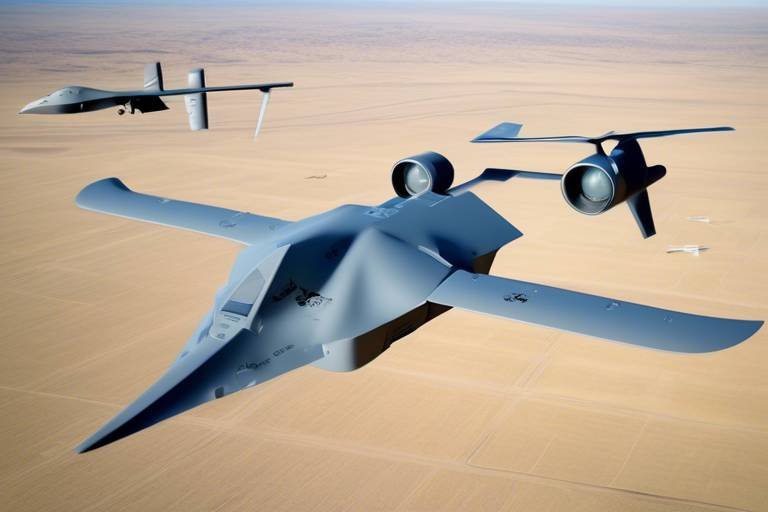How Autonomous Vehicles are Transforming Military Operations
In recent years, the landscape of military operations has undergone a seismic shift, largely fueled by the advent of autonomous vehicles. These cutting-edge technologies are not just a passing trend; they represent a fundamental change in how defense strategies are formulated and executed. Imagine a battlefield where drones and unmanned ground vehicles work in seamless coordination, providing real-time data and support to troops on the ground. This is not science fiction; it is the new reality of modern warfare.
The integration of autonomous vehicles into military operations is revolutionizing traditional methods, enhancing capabilities in logistics, reconnaissance, and combat scenarios. As nations strive to maintain a competitive edge, the adoption of these technologies is becoming increasingly critical. The benefits are manifold, but they come with their own set of challenges that need to be addressed.
Autonomous vehicles are increasingly being integrated into military operations, providing innovative solutions for logistics, reconnaissance, and combat scenarios, enhancing strategic capabilities while reducing human risk on the battlefield. These vehicles can operate independently or in conjunction with human operators, allowing for a more flexible and responsive military force.
The deployment of autonomous vehicles offers numerous advantages, including:
- Increased Efficiency: Autonomous vehicles can operate around the clock without the need for rest, significantly improving mission timelines.
- Reduced Operational Costs: By minimizing the need for human soldiers in high-risk areas, the military can allocate resources more effectively.
- Enhanced Data Collection: Equipped with advanced sensors and AI, these vehicles can gather and analyze data in real-time, providing commanders with critical insights.
- Improved Safety: Autonomous vehicles can take on the most dangerous tasks, keeping personnel out of harm's way.
Despite their potential, the implementation of autonomous vehicles faces challenges such as technological limitations, regulatory hurdles, ethical concerns, and the need for robust cybersecurity measures to protect sensitive military operations. For instance, the reliability of AI systems in unpredictable environments remains a significant concern. Furthermore, the regulatory landscape is still catching up, creating a gap between technological advancements and legal frameworks.
Autonomous vehicles are revolutionizing military logistics by streamlining supply chains, enabling real-time tracking, and ensuring timely delivery of essential supplies to troops in remote or hostile areas. Imagine a scenario where an autonomous drone delivers critical medical supplies to soldiers in the field without risking human life. This capability not only enhances operational efficiency but also significantly improves the chances of mission success.
The use of autonomous vehicles in reconnaissance and surveillance missions allows for greater operational flexibility, improved data gathering, and reduced risk to personnel. These vehicles can cover vast areas quickly and provide commanders with a comprehensive view of the battlefield, which is crucial for making informed decisions.
As technology evolves, autonomous vehicles are expected to play a pivotal role in future combat operations, potentially altering tactics, strategy, and the overall landscape of warfare. The integration of AI and machine learning into these systems will likely enhance their decision-making capabilities, enabling them to adapt to changing battlefield conditions in real time.
The integration of autonomous vehicles in military operations raises significant ethical questions and necessitates the establishment of regulations to govern their use, ensuring accountability and adherence to international laws. Issues such as the potential for autonomous weapons to make life-and-death decisions without human intervention must be addressed to maintain moral and ethical standards in warfare.
Examining real-world case studies of autonomous vehicles in military operations provides insights into their effectiveness, operational challenges, and lessons learned. For instance, the use of drones for surveillance in conflict zones has demonstrated their ability to gather intelligence without putting human lives at risk. These examples can shape future developments in defense technology and inform best practices for deploying autonomous systems.
The future of autonomous vehicles in military operations will depend on continued innovation, collaboration between defense sectors, and partnerships with technology companies to enhance capabilities and address emerging challenges. As we move forward, it is crucial to foster an environment where innovation can thrive while ensuring that ethical considerations are at the forefront of development.
- What are autonomous vehicles?
- Autonomous vehicles are machines capable of performing tasks without human intervention, utilizing AI and sensors to navigate and make decisions.
- How are autonomous vehicles used in military operations?
- They are used for logistics, reconnaissance, surveillance, and even combat, enhancing operational efficiency and safety.
- What are the ethical concerns surrounding autonomous military vehicles?
- Concerns include accountability for decisions made by machines, the potential for misuse, and adherence to international laws of warfare.
- Will autonomous vehicles replace human soldiers?
- No, they are intended to complement human efforts, taking on dangerous tasks and allowing soldiers to focus on strategic decisions.

The Rise of Autonomous Vehicles in Defense
The integration of autonomous vehicles into military operations is not just a trend; it's a revolution that is reshaping how armed forces operate. Imagine a battlefield where drones and unmanned ground vehicles (UGVs) work alongside human soldiers, executing missions with precision and efficiency. This shift is driven by the need for enhanced strategic capabilities while minimizing risks to human life. As technology advances, these vehicles are becoming more sophisticated, capable of performing complex tasks that were once the exclusive domain of human operators.
Historically, military logistics and reconnaissance have relied heavily on human personnel, often placing them in dangerous situations. However, the advent of autonomous vehicles has introduced a new paradigm. These machines can navigate hostile environments, gather intelligence, and transport supplies without putting soldiers at risk. For instance, unmanned aerial vehicles (UAVs) can conduct surveillance over enemy territory, relaying real-time data back to command centers, thereby enhancing situational awareness. This capability allows commanders to make informed decisions without exposing troops to unnecessary danger.
In addition to reconnaissance, autonomous vehicles are proving invaluable in logistics. They can autonomously transport supplies to remote locations, ensuring that troops receive the necessary resources without delay. This is particularly crucial in combat zones where traditional supply chains can be disrupted. By utilizing these vehicles, the military can maintain operational efficiency and effectiveness, even in the most challenging environments.
The rise of autonomous vehicles in defense is also a response to the increasing complexity of modern warfare. As conflicts become more multifaceted, the need for real-time data and rapid response capabilities grows. Autonomous vehicles can be equipped with advanced sensors and communication systems, allowing them to operate in concert with other military assets. This interconnectedness enhances the overall effectiveness of military operations and provides a significant tactical advantage.
However, the transition to autonomous military vehicles is not without its challenges. There are technological hurdles to overcome, such as ensuring reliability and resilience in adverse conditions. Moreover, the military must address ethical considerations regarding the use of machines in combat. Questions about accountability and the decision-making process in life-and-death situations are paramount. As we move forward, these discussions will shape the guidelines and regulations governing the deployment of autonomous vehicles in defense.
In conclusion, the rise of autonomous vehicles in defense signifies a transformative shift in military operations. As these technologies continue to evolve, they promise to enhance operational capabilities while safeguarding the lives of military personnel. The future of warfare is not just about more advanced weapons; it's about smarter, more efficient use of technology to achieve strategic objectives.
- What are autonomous vehicles in military operations?
Autonomous vehicles are unmanned systems that can operate independently or semi-independently in various military roles, including logistics, reconnaissance, and combat. - How do autonomous vehicles enhance military logistics?
They streamline supply chains by autonomously transporting supplies, ensuring timely delivery to troops in remote or hostile areas. - What challenges do autonomous vehicles face in military applications?
Challenges include technological limitations, regulatory hurdles, ethical concerns, and cybersecurity threats. - Are there ethical concerns regarding the use of autonomous vehicles in combat?
Yes, ethical questions arise about accountability and decision-making processes in life-and-death situations.

Benefits of Autonomous Vehicles
When we think about the military, images of tanks, fighter jets, and soldiers often come to mind. But in today's high-tech world, autonomous vehicles are taking center stage, transforming how operations are conducted. These vehicles are not just cool gadgets; they are game-changers in the field of defense. Imagine a battlefield where supplies can be delivered without putting human lives at risk, or where surveillance can be conducted without a soldier ever stepping foot in danger. This is the reality that autonomous vehicles are creating.
One of the most significant benefits of integrating autonomous vehicles into military operations is the increased efficiency they bring. With the ability to operate around the clock without the need for rest, these vehicles can perform tasks that would typically take humans much longer. For instance, logistics operations can run smoother, with autonomous trucks transporting supplies to remote locations without delays. This not only speeds up the process but also ensures that troops have the resources they need when they need them.
Moreover, the reduction of operational costs is another compelling advantage. While the initial investment in autonomous technology can be high, the long-term savings are undeniable. With fewer personnel required for dangerous missions and less likelihood of equipment damage, military budgets can be allocated more efficiently. According to recent studies, the operational costs associated with traditional military logistics can be slashed by up to 30% when employing autonomous systems.
Additionally, autonomous vehicles excel in data collection, providing military leaders with critical insights that were previously hard to obtain. Equipped with advanced sensors and imaging technology, these vehicles can gather intelligence and monitor enemy movements in real-time. This enhanced data collection not only improves situational awareness but also aids in making more informed decisions on the battlefield. Imagine having a bird's-eye view of the entire combat zone, allowing commanders to strategize effectively without risking lives.
Safety is paramount in military operations, and autonomous vehicles significantly improve the safety of military personnel. By taking on high-risk tasks such as reconnaissance or bomb disposal, these vehicles minimize human exposure to danger. This is especially vital in environments where threats are unpredictable. For example, consider a scenario where a bomb disposal unit is sent to defuse an explosive device. With an autonomous vehicle, the operation can be conducted remotely, keeping soldiers out of harm's way.
In summary, the benefits of autonomous vehicles in military operations are profound. They not only enhance efficiency and reduce costs but also improve safety and data collection. As we continue to innovate and embrace these technologies, the military landscape will undoubtedly evolve, leading to more effective and safer operations.
- What types of autonomous vehicles are used in military operations?
Various types include unmanned aerial vehicles (UAVs), unmanned ground vehicles (UGVs), and autonomous naval vessels. - How do autonomous vehicles improve safety for military personnel?
They can perform dangerous tasks remotely, reducing the risk of injury or death in high-threat environments. - What are the cost implications of using autonomous vehicles?
While initial costs can be high, the long-term savings from reduced personnel and operational efficiency can be substantial. - Are there ethical concerns regarding the use of autonomous vehicles in combat?
Yes, the use of autonomous systems raises questions about accountability and the potential for unintended consequences in warfare.

Challenges in Implementation
While the integration of autonomous vehicles into military operations presents a thrilling frontier, it is not without its share of challenges. The first hurdle is technological limitations. Despite significant advancements in AI and robotics, achieving a fully autonomous vehicle that can operate in unpredictable environments remains a work in progress. For instance, adverse weather conditions, difficult terrains, and unexpected obstacles can pose serious challenges, making it essential for these vehicles to have advanced sensors and decision-making algorithms.
Another significant challenge lies in regulatory hurdles. The military operates under strict guidelines and protocols, and the introduction of autonomous systems requires a reevaluation of existing regulations. This includes determining how these vehicles can be deployed in combat scenarios without violating international laws or ethical standards. The military must work closely with lawmakers and regulatory bodies to create frameworks that allow for the safe and effective use of autonomous technology.
Ethical concerns also play a critical role in the discussion around autonomous vehicles. The idea of machines making life-and-death decisions raises profound questions about accountability and moral responsibility. For example, if an autonomous drone mistakenly targets civilians, who is held responsible? This dilemma necessitates a robust ethical framework that guides the development and deployment of these technologies in military settings.
Moreover, cybersecurity poses a significant risk. As military operations increasingly rely on interconnected systems, the potential for cyberattacks grows. Autonomous vehicles, if hacked, could be turned against their operators or used to gather sensitive information. Thus, implementing strong cybersecurity measures is paramount to protect these assets and ensure operational integrity.
To summarize, the challenges in implementing autonomous vehicles in military operations can be categorized as follows:
| Challenge | Description |
|---|---|
| Technological Limitations | Need for advanced sensors and algorithms to handle unpredictable environments. |
| Regulatory Hurdles | Reevaluation of existing laws to accommodate autonomous systems. |
| Ethical Concerns | Questions of accountability and moral responsibility in combat scenarios. |
| Cybersecurity Risks | Vulnerability to cyberattacks that could compromise military operations. |
In conclusion, while the potential of autonomous vehicles in military operations is immense, addressing these challenges is crucial for their successful implementation. As technology continues to evolve, so must our strategies and frameworks to ensure that these innovations enhance military effectiveness without compromising ethical standards or operational security.
- What are the main technological challenges faced by autonomous vehicles? The main challenges include adapting to unpredictable environments, adverse weather, and the need for advanced decision-making algorithms.
- How do regulations affect the deployment of autonomous vehicles in the military? Regulatory hurdles necessitate a reevaluation of existing military protocols and international laws to ensure safe and ethical usage.
- What ethical concerns are associated with autonomous military vehicles? Ethical concerns revolve around accountability for decisions made by machines, particularly in life-and-death situations.
- How do cybersecurity issues impact autonomous vehicles? Cybersecurity risks involve the potential for hacking, which could compromise military operations and sensitive information.

Impact on Logistics and Supply Chains
The integration of autonomous vehicles in military logistics is nothing short of a game changer. Imagine a world where supplies reach soldiers on the front lines without the constant threat of ambush or the need for human drivers. This is becoming a reality as autonomous vehicles streamline the supply chain, enhancing efficiency and reliability. By utilizing advanced technologies such as GPS tracking, AI, and real-time data analytics, military operations can ensure that essential supplies are delivered precisely when and where they are needed.
One of the most significant benefits of these vehicles is their ability to operate in remote or hostile environments. Traditional supply routes can be risky, exposing personnel to enemy fire or other dangers. Autonomous vehicles, however, can navigate these treacherous paths with minimal human intervention, significantly reducing the risk to military personnel. They can be deployed for various logistical tasks, including transporting ammunition, food, medical supplies, and equipment, all while maintaining a high level of operational security.
Moreover, the use of autonomous vehicles allows for real-time tracking of supplies, which is crucial for effective military operations. Commanders can monitor the status of their logistics in real-time, making informed decisions based on up-to-date information. This capability not only enhances situational awareness but also helps in optimizing resource allocation, ensuring that troops are never left without the necessary support. For example, if a supply route is compromised, alternative paths can be calculated and executed on-the-fly, showcasing the flexibility and responsiveness of autonomous logistics.
To illustrate the impact of autonomous vehicles on logistics, consider the following table that outlines key advantages:
| Advantage | Description |
|---|---|
| Increased Efficiency | Autonomous vehicles can operate continuously, reducing downtime and ensuring timely deliveries. |
| Cost Reduction | Lower operational costs due to reduced need for human drivers and enhanced fuel efficiency. |
| Enhanced Safety | Minimized risk to personnel by removing them from dangerous supply routes. |
| Real-time Data | Improved tracking and monitoring capabilities for better decision-making. |
As we look to the future, the evolution of logistics will undoubtedly be shaped by the ongoing advancements in autonomous vehicle technology. The military's adoption of these vehicles is not just about keeping up with technological trends; it’s about redefining what is possible in terms of operational effectiveness and battlefield support. The potential for autonomous vehicles to revolutionize logistics is immense, paving the way for more agile, responsive, and secure military operations.
- What types of autonomous vehicles are used in military logistics? Autonomous trucks, drones, and unmanned ground vehicles are commonly used for various supply missions.
- How do autonomous vehicles enhance safety in military operations? By reducing the need for human drivers in high-risk areas, autonomous vehicles minimize exposure to enemy fire and other dangers.
- Can autonomous vehicles operate in adverse weather conditions? Yes, many autonomous vehicles are equipped with advanced sensors and AI that allow them to navigate effectively in various weather conditions.
- What is the future of autonomous vehicles in military logistics? The future looks promising, with ongoing innovations expected to further enhance their capabilities and integration into military operations.

Enhancing Reconnaissance and Surveillance
In the rapidly evolving landscape of military operations, autonomous vehicles are proving to be game-changers, especially in the realm of reconnaissance and surveillance. Imagine a world where drones and unmanned ground vehicles can scout enemy positions without putting human lives at risk. This is not just a futuristic dream; it’s happening right now. These vehicles are equipped with advanced sensors and cameras that provide real-time data, allowing commanders to make informed decisions faster than ever before.
One of the most significant advantages of using autonomous vehicles for reconnaissance is their ability to cover vast areas quickly and efficiently. Traditional reconnaissance methods often involve sending troops into potentially dangerous territories, which can be both time-consuming and risky. With autonomous vehicles, military forces can gather crucial intelligence without exposing personnel to unnecessary danger. For instance, a drone can fly over a hostile area, capturing high-resolution images and videos, while ground-based autonomous vehicles can traverse rugged terrains to collect data from locations that would be challenging for humans to access.
Moreover, the data collected by these autonomous systems is not just about visuals; it’s about creating a comprehensive operational picture. Advanced analytics can process the information gathered, identifying patterns and anomalies that might go unnoticed by human eyes. This capability enhances situational awareness for military commanders, enabling them to respond to threats more swiftly and effectively. In essence, the integration of autonomous vehicles into reconnaissance missions transforms the battlefield into a more transparent and manageable environment.
However, it’s essential to recognize that while autonomous vehicles enhance reconnaissance capabilities, they also come with their own set of challenges. For example, the reliance on technology means that any failures or glitches in the systems can lead to significant operational setbacks. Furthermore, the vast amount of data generated requires robust cybersecurity measures to ensure that sensitive information does not fall into the wrong hands. Protecting these systems from hacking and other cyber threats is crucial for maintaining operational integrity.
As we look to the future, the potential for autonomous vehicles in reconnaissance and surveillance seems limitless. With ongoing advancements in artificial intelligence and machine learning, these vehicles will become even more sophisticated, capable of making decisions in real-time based on the data they collect. This will not only enhance operational efficiency but also redefine the way military operations are conducted.
In summary, the integration of autonomous vehicles into military reconnaissance and surveillance operations is revolutionizing how data is collected and analyzed on the battlefield. By reducing human risk and increasing efficiency, these technologies are paving the way for a new era of military strategy. The future holds exciting possibilities, but it also demands careful consideration of the ethical and operational challenges that accompany such advancements.
- What types of autonomous vehicles are used in reconnaissance? Autonomous drones and unmanned ground vehicles are commonly used for reconnaissance purposes, equipped with advanced sensors for data collection.
- How does autonomous reconnaissance improve military strategy? It enhances situational awareness, allowing commanders to make quicker, more informed decisions while keeping personnel safe.
- What are the risks associated with using autonomous vehicles in surveillance? Risks include potential technological failures, cybersecurity threats, and the ethical implications of relying on machines for critical decisions.
- Can autonomous vehicles operate in adverse weather conditions? Many modern autonomous vehicles are designed to withstand various weather conditions, but performance can vary based on the technology used.

Future of Combat Operations
The landscape of warfare is on the brink of a revolutionary transformation, primarily driven by the integration of autonomous vehicles. As technology continues to advance at a breakneck pace, these vehicles are not just tools but are becoming essential components of modern combat operations. Imagine a battlefield where drones and ground vehicles operate in unison, executing complex maneuvers without direct human intervention. This is not science fiction; it's the future of military engagements.
One of the most significant impacts of autonomous vehicles on combat operations is their ability to enhance tactical flexibility. Commanders can deploy these vehicles for reconnaissance missions, gather intelligence, and even perform direct strikes while keeping human personnel out of harm's way. This capability allows military strategists to rethink traditional tactics and adapt to rapidly changing battlefield conditions. For instance, an autonomous drone could be dispatched to scout an area, relay real-time data back to command centers, and even engage targets, all while minimizing the risk to human life.
Moreover, the integration of artificial intelligence (AI) into these vehicles means that they can learn from their environments and make decisions based on vast amounts of data. This not only increases their effectiveness but also enhances the overall battlefield awareness of commanders. Picture a scenario where AI algorithms analyze the terrain, enemy movements, and weather conditions to recommend the best course of action. This level of insight could drastically reduce response times and improve operational outcomes.
However, the future isn't without its challenges. The reliance on autonomous systems raises critical questions about command and control. Who is responsible if an autonomous vehicle malfunctions or makes a decision that leads to unintended consequences? These ethical dilemmas must be addressed as military operations evolve. Additionally, the potential for hacking and cybersecurity threats poses a significant risk, demanding robust security measures to protect these advanced systems.
Furthermore, the integration of autonomous vehicles into combat operations necessitates a shift in training and operational protocols. Military personnel will need to adapt to working alongside machines, understanding their capabilities and limitations. This could lead to a new kind of soldier—one who is not only a combatant but also a skilled operator of advanced technology.
As we look ahead, it's clear that the future of combat operations will be shaped by innovation and collaboration. Partnerships between military organizations and tech companies will be vital to develop the next generation of autonomous systems. These collaborations can drive the creation of more sophisticated vehicles that can operate in diverse environments, from urban landscapes to rugged terrains.
In conclusion, the integration of autonomous vehicles into military operations heralds a new era of warfare. While challenges remain, the potential benefits in terms of efficiency, safety, and strategic advantage are too significant to ignore. As we embrace this technological revolution, the military must navigate the ethical and operational complexities to ensure that the future of combat operations is both effective and responsible.
- What are autonomous vehicles in military operations? Autonomous vehicles are unmanned systems that can operate independently or semi-independently in various military roles such as reconnaissance, logistics, and combat.
- How do autonomous vehicles enhance battlefield effectiveness? They improve efficiency, reduce human risk, and provide real-time data, allowing for better decision-making and tactical flexibility.
- What are the ethical concerns surrounding autonomous military vehicles? Key concerns include accountability for decisions made by machines, the potential for errors, and the implications of using AI in combat situations.
- How will training change with the introduction of autonomous vehicles? Military personnel will need to learn how to operate and collaborate with these technologies, requiring new training programs and operational protocols.

Ethical Considerations and Regulations
The integration of autonomous vehicles in military operations is not just a technological advancement; it raises profound ethical questions that society must grapple with. As these vehicles become more prevalent on the battlefield, the implications of their use extend beyond mere operational efficiency. For instance, who is responsible when an autonomous vehicle makes a decision that leads to unintended consequences? Is it the programmer, the military commander, or the machine itself? These questions are crucial as they touch upon accountability and moral responsibility.
Furthermore, the deployment of autonomous systems in combat scenarios introduces the risk of dehumanizing warfare. When machines are tasked with making split-second decisions, the emotional and moral considerations that human soldiers typically weigh may be bypassed. This shift could lead to a troubling landscape where the value of human life is diminished, and the complexities of conflict are oversimplified. As such, there is an urgent need for comprehensive regulations that govern the use of these technologies, ensuring they are employed ethically and responsibly.
To address these ethical dilemmas, several key considerations must be taken into account:
- Accountability: Establishing clear lines of responsibility for actions taken by autonomous vehicles.
- Compliance with International Law: Ensuring that the deployment of autonomous systems adheres to existing humanitarian laws and treaties.
- Transparency: Developing protocols that allow for the scrutiny of autonomous decision-making processes.
- Public Perception: Engaging with the public to build trust and understanding around the use of autonomous technologies in military settings.
Moreover, the regulatory landscape surrounding autonomous vehicles is still evolving. Governments and military organizations must collaborate to create frameworks that address the unique challenges posed by these technologies. This includes not only ethical guidelines but also technical standards to ensure the reliability and security of autonomous systems. For example, a
| Regulatory Aspect | Description |
|---|---|
| Accountability | Defining who is liable for the actions of autonomous vehicles. |
| Compliance | Ensuring operations align with international humanitarian laws. |
| Transparency | Creating mechanisms for oversight and review of autonomous decision-making. |
| Public Engagement | Involving the public in discussions about the ethical implications of autonomous military technology. |
In conclusion, as we forge ahead into an era where autonomous vehicles are integral to military operations, it is imperative to prioritize ethical considerations and establish robust regulations. The balance between technological advancement and moral responsibility will define the future of warfare. Only through careful deliberation and proactive governance can we ensure that these powerful tools are used to enhance, rather than undermine, our commitment to human dignity and ethical conduct in conflict.
- What are the main ethical concerns regarding autonomous military vehicles?
The primary concerns include accountability for decisions made by these vehicles, potential dehumanization of warfare, and compliance with international laws. - How can regulations help in the use of autonomous vehicles?
Regulations can establish guidelines for responsible use, ensure accountability, and help maintain compliance with humanitarian laws. - What role does public perception play in the deployment of autonomous military vehicles?
Public perception is crucial as it influences trust in military operations and the acceptance of new technologies in warfare.

Case Studies of Successful Implementation
The integration of autonomous vehicles into military operations has not just been a concept; it's a reality that has been tested and proven in various scenarios. One of the most notable examples is the use of unmanned aerial vehicles (UAVs) in reconnaissance missions during the conflicts in the Middle East. These drones have provided real-time intelligence, allowing military commanders to make informed decisions without putting personnel at risk. For instance, the MQ-1 Predator drone has been instrumental in gathering surveillance data, conducting strikes, and even aiding in search and rescue operations. Its ability to loiter over an area for extended periods has transformed how the military approaches reconnaissance.
Another compelling case study involves the deployment of autonomous ground vehicles (AGVs) in logistics operations. The U.S. Army has been experimenting with the TerraMax, an autonomous vehicle designed to transport supplies in combat zones. This vehicle can navigate through difficult terrains and deliver essential supplies to troops without risking human lives. The success of TerraMax in various field tests has demonstrated that autonomous vehicles can significantly enhance logistical operations, ensuring that troops are well-equipped even in the most challenging environments.
Moreover, the Joint Tactical Autonomous Aerial Resupply System (JTARAS) is another fascinating example. This system was designed to autonomously deliver supplies to troops in remote locations, minimizing the need for risky supply convoys. During trials, JTARAS proved its capability to navigate complex environments and deliver payloads accurately, showcasing how autonomous systems can streamline military logistics while enhancing safety. The success of these trials has led to discussions about scaling up the technology for broader military use, indicating a promising future for autonomous logistics.
In addition to these examples, the integration of autonomous vehicles also extends to naval operations. The U.S. Navy has been testing the Sea Hunter, an autonomous surface vessel designed for anti-submarine warfare. This vessel can operate for extended periods without human intervention, providing a cost-effective solution for maritime patrols. Its ability to gather intelligence and operate in potentially hostile waters without risking crew lives is a game-changer for naval strategy.
These case studies illustrate not only the effectiveness of autonomous vehicles in military operations but also the challenges they present. For instance, while the technology has proven reliable, issues such as cybersecurity threats and the need for regulatory frameworks remain significant hurdles. Nevertheless, the successes achieved so far provide a solid foundation for future advancements in military technology.
- What are autonomous vehicles in military operations? Autonomous vehicles are unmanned systems that operate independently or with minimal human intervention in military contexts, including drones and ground vehicles.
- How do autonomous vehicles enhance military logistics? They streamline supply chains, reduce the risk to personnel, and ensure timely delivery of supplies, especially in remote or dangerous areas.
- What are the main challenges of implementing autonomous vehicles in the military? Key challenges include technological limitations, ethical concerns, regulatory hurdles, and cybersecurity risks.
- Can autonomous vehicles be used for combat operations? Yes, they can be utilized for reconnaissance, surveillance, and even direct combat roles, depending on their design and capabilities.
- What is the future of autonomous vehicles in military operations? The future looks promising, with continued innovation and collaboration expected to enhance capabilities and address emerging challenges.

The Path Forward: Innovation and Collaboration
The landscape of military operations is rapidly changing, and at the heart of this transformation lies the integration of autonomous vehicles. As we look to the future, it’s clear that the path forward will be paved with innovation and collaboration. The military cannot navigate this complex terrain alone; it requires a robust partnership with technology companies, research institutions, and even international allies. Think of it as a symphony—each player must harmonize their contributions to create a powerful and effective defense strategy.
One of the most exciting aspects of this collaboration is the potential for cross-disciplinary innovation. By bringing together experts from various fields—robotics, artificial intelligence, cybersecurity, and logistics—the military can develop autonomous systems that are not only effective but also adaptable to ever-changing battlefield conditions. Imagine a drone that can not only survey enemy positions but also adapt its flight path in real-time based on environmental factors or enemy countermeasures. This level of adaptability is only possible through collaborative efforts.
Moreover, collaboration extends beyond technology development; it also encompasses training and operational integration. Military personnel need to be equipped with the skills to operate and maintain these advanced systems. This requires a comprehensive training program that incorporates both theoretical knowledge and practical experience. By working closely with technology partners, the military can ensure that its personnel are well-prepared to leverage these new tools effectively.
Another crucial aspect of this collaborative effort is the establishment of regulatory frameworks. As autonomous vehicles become more prevalent in military operations, there will be a need for clear guidelines governing their use. This includes not only operational protocols but also ethical considerations surrounding their deployment. By engaging with policymakers, military leaders can help shape regulations that ensure the responsible use of autonomous technology, aligning military operations with international law and ethical standards.
To illustrate the potential of this collaborative approach, consider the following table that outlines key areas where innovation and collaboration can significantly enhance military operations:
| Area | Potential Innovations | Collaborative Opportunities |
|---|---|---|
| Logistics | Automated supply chains, real-time tracking | Partnerships with tech firms specializing in logistics |
| Surveillance | AI-driven data analysis, enhanced reconnaissance drones | Joint research with universities and think tanks |
| Cybersecurity | Advanced encryption, threat detection systems | Collaboration with cybersecurity experts and firms |
As we forge ahead, it’s essential to foster a culture of innovation within military organizations. This means encouraging creative thinking and embracing new ideas, even if they challenge traditional military doctrines. By doing so, the military can remain agile and responsive to the challenges of modern warfare. The collaboration between various sectors will not only enhance the capabilities of autonomous vehicles but also ensure that they are integrated into a cohesive strategy that prioritizes mission success and the safety of personnel.
In conclusion, the future of military operations involving autonomous vehicles hinges on a commitment to innovation and collaboration. By working together, the military and its partners can unlock the full potential of these technologies, creating a more effective and adaptable defense force. The journey ahead is filled with challenges, but with the right partnerships and a shared vision, the military can lead the way into a new era of warfare.
- What are autonomous vehicles? Autonomous vehicles are machines capable of performing tasks without human intervention, using advanced technologies like AI and sensors.
- How do autonomous vehicles benefit military operations? They enhance efficiency, reduce risks to personnel, and improve data collection and logistics.
- What challenges do autonomous vehicles face in military contexts? Challenges include technological limitations, regulatory hurdles, and ethical concerns.
- Why is collaboration important for the future of military autonomous vehicles? Collaboration fosters innovation, enhances training, and helps establish necessary regulations for responsible use.
Frequently Asked Questions
- What are autonomous vehicles and how are they used in military operations?
Autonomous vehicles are unmanned systems that can operate without human intervention. In military operations, they are utilized for various purposes like logistics, reconnaissance, and combat scenarios. These vehicles enhance strategic capabilities while minimizing risks to personnel on the battlefield.
- What benefits do autonomous vehicles provide to the military?
Autonomous vehicles offer numerous advantages, including increased operational efficiency, reduced costs, improved safety for military personnel, and enhanced data collection capabilities. They can operate in high-risk environments, allowing troops to focus on more critical tasks.
- What challenges do military forces face when implementing autonomous vehicles?
Despite their potential, several challenges hinder the implementation of autonomous vehicles. These include technological limitations, regulatory hurdles, ethical concerns regarding their use, and the necessity for robust cybersecurity measures to protect sensitive military operations.
- How do autonomous vehicles impact military logistics and supply chains?
Autonomous vehicles revolutionize military logistics by streamlining supply chains, enabling real-time tracking, and ensuring timely delivery of essential supplies to troops, especially in remote or hostile areas. This efficiency can be a game-changer in critical situations.
- What role do autonomous vehicles play in reconnaissance and surveillance?
In reconnaissance and surveillance missions, autonomous vehicles provide greater operational flexibility and improved data gathering. They reduce the risk to personnel while offering commanders critical situational awareness, making decision-making more effective on the battlefield.
- What are the ethical considerations surrounding the use of autonomous vehicles in military operations?
The integration of autonomous vehicles raises significant ethical questions, such as accountability for decisions made by these systems and adherence to international laws. Establishing regulations is essential to ensure responsible usage and maintain ethical standards in military operations.
- Can you provide examples of successful implementation of autonomous vehicles in military settings?
Yes! Real-world case studies illustrate the effectiveness of autonomous vehicles in military operations. These examples highlight operational challenges faced and the lessons learned, which are crucial for shaping future developments in defense technology.
- What does the future hold for autonomous vehicles in military operations?
As technology continues to evolve, autonomous vehicles are expected to play a pivotal role in future combat operations. They may alter tactics and strategies, significantly changing the landscape of warfare as we know it.


